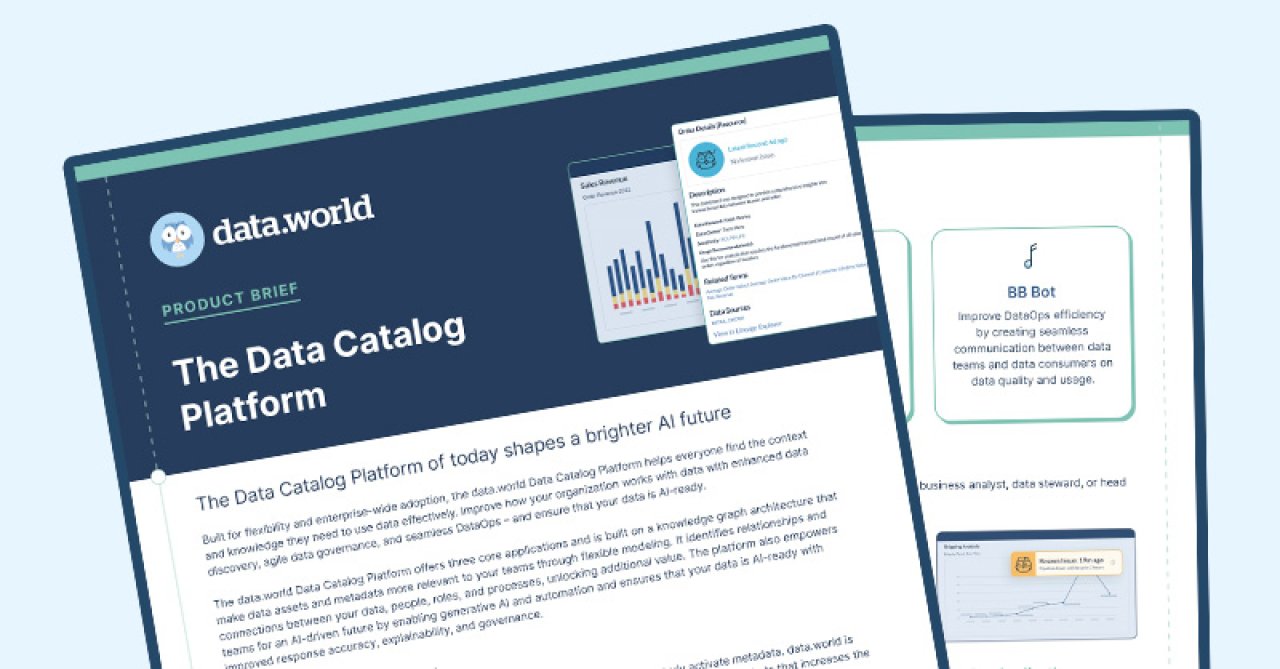







Jan 27, 2025

Liz Elfman
Content Marketing Director

Effective data management is what makes a data-driven organization successful. It allows teams to make smarter decisions and stay ahead in a competitive industry. Successful organizations have discovered that their journey toward data-driven enlightenment requires not just data storage, but deeper understanding.
However, at this point the volume of data has transcended human scale. Adding to the complexity, data protection regulations are becoming stricter to protect user rights which itself is one of the biggest challenges. In this landscape of perpetual flux, data catalogs and metadata management have emerged as promising tools to simplify data management chaos. In this blog, we will break down how we navigate the endless seas of data that define our digital age.
A data catalog is a centralized library of data assets where you can manage and collaborate on them. It stores detailed metadata (data about data) with consistent formatting and detailed lineage so users can quickly locate and understand the data they need for analysis.
Here are the key functionalities of data catalogs:
Data discovery and search: Quickly find data assets through metadata-based search.
Tagging and organization: Apply contextual tags for easier classification and retrieval.
Collaboration: Help teams to collaborate in a single platform to share insights and documentation.
Data governance: Manage access controls and implement regulatory compliance.
Centralization: Combine data assets into a single, searchable platform to make data more accessible and meaningful for technical and non-technical users.
Integration: Integrate data from diverse sources into a single platform.
Automation: Use AI for automated tagging, metadata management, and updates.
Modern data catalogs use AI and machine learning to automate and boost the efficiency of most data cataloging functionalities. This reduces manual effort and increases the accuracy of data records in real time.
Metadata, on the other hand, provides necessary context about data assets like their definitions, source, and lineage. So, you can combine modern data catalogs with metadata management tools and frameworks (like DAMA-DMBOK, ISO/IEC 11179, TOGAF, CDMC, etc.) to organize data and make it easy to navigate.
Note: Don’t confuse data catalogs with data dictionaries. Learn the key differences here.
Metadata management organizes and maintains metadata. This process adds context to each data asset by tracking its lineage (where the data comes from and how it changes) and records its flow across the data management life cycle. It plays a central role in data management by making data easily searchable through its context and keeping the records consistent.
The primary functions of metadata management systems are:
Metadata storage: Centralizes metadata in a catalog for easy access and retrieval.
Curation: Organizes and enriches metadata by tagging, classifying, and adding descriptions.
Quality control: Keeps metadata accurate and complete to improve data trustworthiness.
Lineage tracking: Tracks the history and flow of data for increased transparency.
Combined, these functions provide the foundation for agile data governance by creating a clear structure for data ownership and usage policies. It increases accountability with role-based access, which allows only authorized users to access sensitive information. This reduces the risks of data breaches.
A data catalog is like a GPS app that makes it easy for anyone to find the shortest route to their destination (data). Meanwhile, metadata management creates the map behind the scenes, where roads (data systems) are well-defined and connected. Both simplify our search journey to reach the destination (data) while maintaining a secure backend structure.
Here’s a table to help you understand the difference between data catalogs and metadata management.
| Aspect | Data catalog | Metadata management |
|---|---|---|
| Focus | Simplify data discovery and accessibility for all users. | Collect and maintain metadata for governance and quality. |
| Primary functionality | Enables data discovery and collaboration through a user-friendly interface. | Focuses on metadata storage and lineage tracking with consistency and governance. |
| Outcomes | Helps us quickly find and use data for decision-making. | Provides structured metadata that supports compliance and consistency. |
| Audience | Suitable for business users, analysts, and non-technical teams who need quick insights. | Made for IT teams, data stewards, or technical users responsible for backend data security. |
| Example | Like a library’s catalog where you can find books (data) easily through titles, authors, or subjects. | Like an archivist who keeps books (data) properly categorized, labeled, and preserved. |
Data catalogs are powered by metadata (descriptions, lineage, tags, ownership details), which provides the context and structure to make data discoverable and meaningful. It enables data catalogs to deliver quick and natural language data discovery.
Metadata management systems feed metadata into data catalogs in a structured, user-friendly format accessible to technical and non-technical users. This structured view also eases collaboration and reduces confusion about data usage.
Together, data catalogs and metadata management create a strong data management framework that gives the following benefits:
Simplifies data discovery and accessibility.
Ensures the accuracy and compliance of the information within the catalog.
Bridges the gap between governance and usability so organizations can make data-driven decisions while maintaining control and consistency.
The data catalog’s market size was valued at $0.8 billion in 2023 and is forecasted to grow at a 22.7% CAGR. However, the global metadata management tools market size was valued at $9.1 billion in 2023 and is projected to grow with a 19.6% CAGR.
The stats appear to be high and growing for both tools, but how would you tell which one is right for you? Well, it all depends on your organization’s goals.
A data catalog could be an ideal choice when the focus is on enabling your team to quickly discover and access data with features like knowledge graph based search or cross-team collaboration.
Metadata management would be ideal if you have to maintain data consistency, quality, and compliance in any highly regulated industry like medical or finance.
The best approach is to combine both. That way, organizations can easily balance accessibility with strict governance, especially in large, data-driven environments. Here are two key tips to implement this:
Use AI-based tools to automate metadata ingestion and tagging.
Use a modern data catalog to align business and technical metadata in a unified platform that simplifies team collaboration.
A knowledge graph structure organizes and links information into nodes (representing data assets) and edges (representing relationships). It is used in data catalogs to connect multiple datasets and their metadata in machine-readable format. Here's what a knowledge graph-backed data catalog can do:
Provide context: Creates flexible and intelligent connections between data assets like a web that helps users search and understand data through context.
Enable quicker data discovery: Uses plain language search to deliver contextually relevant results.
Support scalability and adaptability: Adapts easily as new data sources are added, so the catalog grows without becoming siloed.
Improve collaboration: Gives a unified view of data relationships to promote team collaboration, including business stakeholders.
Read this blog to see how data.world helped Snowflake improve its data discovery.
Data catalogs and metadata management have distinct but complementary purposes. Catalogs prioritize user-friendly data discovery and collaboration, whereas metadata management builds the backbone of governance to keep data consistent and compliant. Together, these tools provide a powerful framework for addressing data accessibility and governance challenges.
However, choosing the right tools depends on aligning with your organization’s goals and challenges. But what if you can have the best of both?
As a leading provider of data catalog solutions, data.world integrates data cataloging and metadata management features into a unified platform. Built on knowledge graph architecture, it intelligently and flexibly connects data assets to help you find insights. We also provide AI-driven capabilities to automate metadata management and increase data searchability, tagging, and context.
Schedule a demo to see how our knowledge graph based data catalog with advanced metadata management features can help your organization.

Effective data management is what makes a data-driven organization successful. It allows teams to make smarter decisions and stay ahead in a competitive industry. Successful organizations have discovered that their journey toward data-driven enlightenment requires not just data storage, but deeper understanding.
However, at this point the volume of data has transcended human scale. Adding to the complexity, data protection regulations are becoming stricter to protect user rights which itself is one of the biggest challenges. In this landscape of perpetual flux, data catalogs and metadata management have emerged as promising tools to simplify data management chaos. In this blog, we will break down how we navigate the endless seas of data that define our digital age.
A data catalog is a centralized library of data assets where you can manage and collaborate on them. It stores detailed metadata (data about data) with consistent formatting and detailed lineage so users can quickly locate and understand the data they need for analysis.
Here are the key functionalities of data catalogs:
Data discovery and search: Quickly find data assets through metadata-based search.
Tagging and organization: Apply contextual tags for easier classification and retrieval.
Collaboration: Help teams to collaborate in a single platform to share insights and documentation.
Data governance: Manage access controls and implement regulatory compliance.
Centralization: Combine data assets into a single, searchable platform to make data more accessible and meaningful for technical and non-technical users.
Integration: Integrate data from diverse sources into a single platform.
Automation: Use AI for automated tagging, metadata management, and updates.
Modern data catalogs use AI and machine learning to automate and boost the efficiency of most data cataloging functionalities. This reduces manual effort and increases the accuracy of data records in real time.
Metadata, on the other hand, provides necessary context about data assets like their definitions, source, and lineage. So, you can combine modern data catalogs with metadata management tools and frameworks (like DAMA-DMBOK, ISO/IEC 11179, TOGAF, CDMC, etc.) to organize data and make it easy to navigate.
Note: Don’t confuse data catalogs with data dictionaries. Learn the key differences here.
Metadata management organizes and maintains metadata. This process adds context to each data asset by tracking its lineage (where the data comes from and how it changes) and records its flow across the data management life cycle. It plays a central role in data management by making data easily searchable through its context and keeping the records consistent.
The primary functions of metadata management systems are:
Metadata storage: Centralizes metadata in a catalog for easy access and retrieval.
Curation: Organizes and enriches metadata by tagging, classifying, and adding descriptions.
Quality control: Keeps metadata accurate and complete to improve data trustworthiness.
Lineage tracking: Tracks the history and flow of data for increased transparency.
Combined, these functions provide the foundation for agile data governance by creating a clear structure for data ownership and usage policies. It increases accountability with role-based access, which allows only authorized users to access sensitive information. This reduces the risks of data breaches.
A data catalog is like a GPS app that makes it easy for anyone to find the shortest route to their destination (data). Meanwhile, metadata management creates the map behind the scenes, where roads (data systems) are well-defined and connected. Both simplify our search journey to reach the destination (data) while maintaining a secure backend structure.
Here’s a table to help you understand the difference between data catalogs and metadata management.
| Aspect | Data catalog | Metadata management |
|---|---|---|
| Focus | Simplify data discovery and accessibility for all users. | Collect and maintain metadata for governance and quality. |
| Primary functionality | Enables data discovery and collaboration through a user-friendly interface. | Focuses on metadata storage and lineage tracking with consistency and governance. |
| Outcomes | Helps us quickly find and use data for decision-making. | Provides structured metadata that supports compliance and consistency. |
| Audience | Suitable for business users, analysts, and non-technical teams who need quick insights. | Made for IT teams, data stewards, or technical users responsible for backend data security. |
| Example | Like a library’s catalog where you can find books (data) easily through titles, authors, or subjects. | Like an archivist who keeps books (data) properly categorized, labeled, and preserved. |
Data catalogs are powered by metadata (descriptions, lineage, tags, ownership details), which provides the context and structure to make data discoverable and meaningful. It enables data catalogs to deliver quick and natural language data discovery.
Metadata management systems feed metadata into data catalogs in a structured, user-friendly format accessible to technical and non-technical users. This structured view also eases collaboration and reduces confusion about data usage.
Together, data catalogs and metadata management create a strong data management framework that gives the following benefits:
Simplifies data discovery and accessibility.
Ensures the accuracy and compliance of the information within the catalog.
Bridges the gap between governance and usability so organizations can make data-driven decisions while maintaining control and consistency.
The data catalog’s market size was valued at $0.8 billion in 2023 and is forecasted to grow at a 22.7% CAGR. However, the global metadata management tools market size was valued at $9.1 billion in 2023 and is projected to grow with a 19.6% CAGR.
The stats appear to be high and growing for both tools, but how would you tell which one is right for you? Well, it all depends on your organization’s goals.
A data catalog could be an ideal choice when the focus is on enabling your team to quickly discover and access data with features like knowledge graph based search or cross-team collaboration.
Metadata management would be ideal if you have to maintain data consistency, quality, and compliance in any highly regulated industry like medical or finance.
The best approach is to combine both. That way, organizations can easily balance accessibility with strict governance, especially in large, data-driven environments. Here are two key tips to implement this:
Use AI-based tools to automate metadata ingestion and tagging.
Use a modern data catalog to align business and technical metadata in a unified platform that simplifies team collaboration.
A knowledge graph structure organizes and links information into nodes (representing data assets) and edges (representing relationships). It is used in data catalogs to connect multiple datasets and their metadata in machine-readable format. Here's what a knowledge graph-backed data catalog can do:
Provide context: Creates flexible and intelligent connections between data assets like a web that helps users search and understand data through context.
Enable quicker data discovery: Uses plain language search to deliver contextually relevant results.
Support scalability and adaptability: Adapts easily as new data sources are added, so the catalog grows without becoming siloed.
Improve collaboration: Gives a unified view of data relationships to promote team collaboration, including business stakeholders.
Read this blog to see how data.world helped Snowflake improve its data discovery.
Data catalogs and metadata management have distinct but complementary purposes. Catalogs prioritize user-friendly data discovery and collaboration, whereas metadata management builds the backbone of governance to keep data consistent and compliant. Together, these tools provide a powerful framework for addressing data accessibility and governance challenges.
However, choosing the right tools depends on aligning with your organization’s goals and challenges. But what if you can have the best of both?
As a leading provider of data catalog solutions, data.world integrates data cataloging and metadata management features into a unified platform. Built on knowledge graph architecture, it intelligently and flexibly connects data assets to help you find insights. We also provide AI-driven capabilities to automate metadata management and increase data searchability, tagging, and context.
Schedule a demo to see how our knowledge graph based data catalog with advanced metadata management features can help your organization.